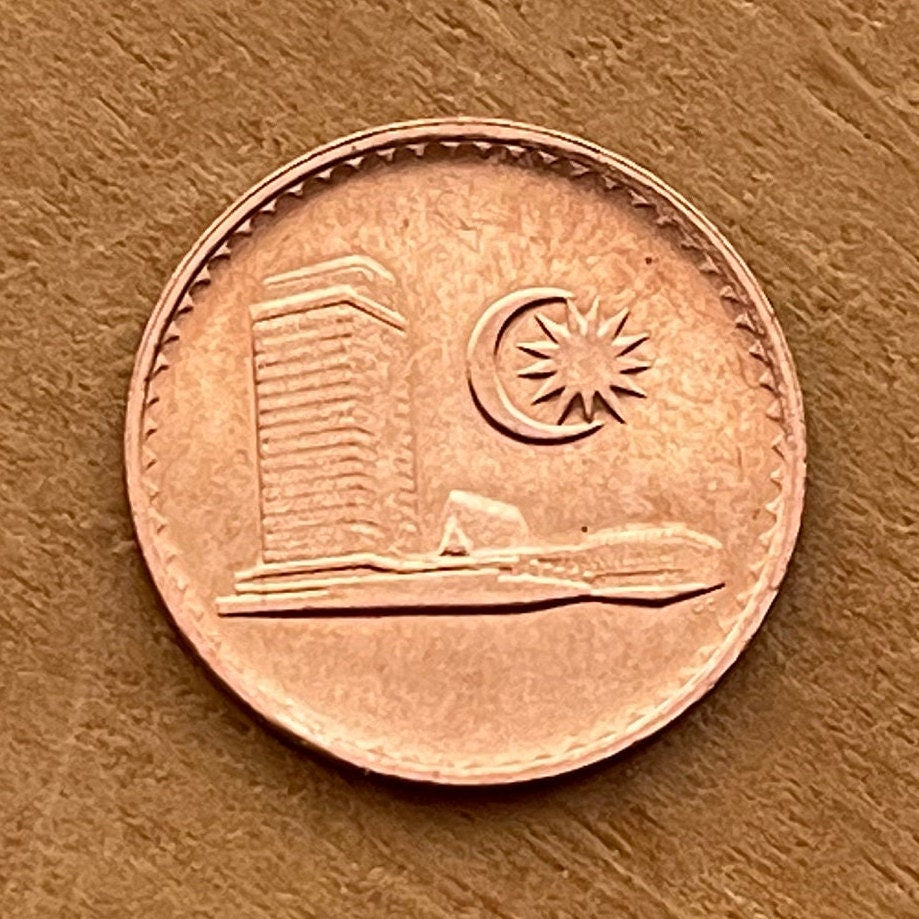elemintalshop
Houses of Parliament & Star and Crescent 1 Sen Malaysia Authentic Coin Money for Jewelry and Craft Making
Houses of Parliament & Star and Crescent 1 Sen Malaysia Authentic Coin Money for Jewelry and Craft Making
Couldn't load pickup availability
Houses of Parliament & Star and Crescent 1 Sen Malaysia Authentic Coin Money for Jewelry and Craft Making
Reverse: Parliament houses; crescent and star right
Obverse: Value and date
Lettering: MALAYSIA
1 SEN
Features
Issuer Malaysia
Period Federal elective constitutional monarchy (1963-date)
Type Standard circulation coin
Years 1967-1981
Value 1 Sen
0.01 MYR = USD 0.0024
Currency Ringgit (1967-date)
Composition Copper
Weight 1.94 g
Diameter 17.78 mm
Thickness 1.25 mm
Shape Round
Orientation Medal alignment ↑↑
Number N# 5939
References KM# 1, Schön# 48
WIkipedia:
The Malaysian Houses of Parliament (Malay: Bangunan Parlimen Malaysia), is a building complex where the Malaysian Parliament assembles. The structure is located at the Lake Gardens in Kuala Lumpur, close to the Malaysian National Monument.
The complex comprises two parts, a 3-story main building and a 17-story 77 metre tall tower.[1] The main building hosts the Dewan Rakyat (House of Representatives) and the Dewan Negara (Senate) while representatives' offices are located in the tower.
The complex was constructed during the period when the federal government was based in Kuala Lumpur. While the vast majority of government operations has moved to Putrajaya since the late-1990s, the parliament continues to convene at Kuala Lumpur's Parliament House.
Construction
Tunku Abdul Rahman, the first Malayan Prime Minister, suggested the construction of the Houses of Parliament in December 1959. The construction of the building cost RM18 million. Designed by Ivor Shipley, a British architect in the Public Works Department, the construction commenced in September 1962, and the opening of the new Parliament building was officiated by Tuanku Syed Putra ibni Almarhum Syed Hassan Jamalullail, the third Yang di-Pertuan Agong, on 21 November 1963.[2][3] Tunku Abdul Rahman's statue was erected near the Parliament Square on 1971. The statue was designed by an American sculptor, Felix de Weldon who also designed the Malaysian National Monument.
In culture
The buildings have only weakly represented Malaysian government to the world, but are symbolic as that in Malaysia. The building has also been prominently featured on reverse of the first series sen coins and the first and second series M$1,000 banknotes.
*************
Wikipedia:
In the later 20th century, the star and crescent have acquired a popular interpretation as a "symbol of Islam", occasionally embraced by Arab nationalism or Islamism in the 1970s to 1980s, but often rejected as erroneous or unfounded by Muslim commentators in more recent times.
*******
Wikipedia:
The star and crescent is an iconographic symbol used in various historical contexts, prominently as a symbol of the Ottoman Empire, with numerous modern countries still using it as a national symbol. It is also often it was developed at Kingdom of Pontus at Hellenistic period considered as a symbol of Islam by extension. It is the conjoined representation of a crescent and a star, both elements have a long prior history in the iconography of the Ancient Near East as representing either the Sun and Moon or the Moon and Morning Star (or their divine personifications). Coins with crescent and star symbols represented separately have a longer history, with possible ties to older Mesopotamian iconography. The star, or Sun, is often shown within the arc of the crescent (also called star in crescent, or star within crescent, for disambiguation of depictions of a star and a crescent side by side); In numismatics in particular, the term crescent and pellet is used in cases where the star is simplified to a single dot.
The combination is found comparatively rarely in late medieval and early modern heraldry. It rose to prominence with its adoption as the flag and national symbol of the Ottoman Empire and some of its administrative divisions (eyalets and vilayets) and later in the 19th-century Westernizing tanzimat (reforms). The Ottoman flag of 1844, with a white ay-yıldız (Turkish for "crescent-star") on a red background, continues to be in use as the flag of the Republic of Turkey, with minor modifications. Other states formerly part of the Ottoman Empire also used the symbol, including Libya (1951–1969 and after 2011), Tunisia (1831) and Algeria (1958). The same symbol was used in other national flags introduced during the 20th century, including the flags of Azerbaijan (1918), Pakistan (1947), Malaysia (1948), Singapore (1959), Mauritania (1959), Uzbekistan (1991), Turkmenistan (1991), Comoros (2001).
Share










5 stars review from W









